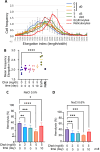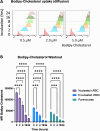Production and stability of cultured red blood cells depends on the concentration of cholesterol in culture medium
- PMID: 38971841
- PMCID: PMC11227516
- DOI: 10.1038/s41598-024-66440-z
Production and stability of cultured red blood cells depends on the concentration of cholesterol in culture medium
Abstract
The production of cultured red blood cells (cRBC) for transfusion purposes requires large scale cultures and downstream processes to purify enucleated cRBC. The membrane composition, and cholesterol content in particular, are important during proliferation of (pro)erythroblasts and for cRBC quality. Therefore, we tested the requirement for cholesterol in the culture medium during expansion and differentiation of erythroid cultures with respect to proliferation, enucleation and purification by filtration. The low cholesterol level (22 µg/dl) in serum free medium was sufficient to expand (pro)erythroblast cultures. Addition of 2.0 or 5.0 mg/dL of free cholesterol at the start of differentiation induction inhibited enucleation compared to the default condition containing 3.3 mg/dl total cholesterol derived from the addition of Omniplasma to serum free medium. Addition of 5.0 mg/dl cholesterol at day 5 of differentiation did not affect the enucleation process but significantly increased recovery of enucleated cRBC following filtration over leukodepletion filters. The addition of cholesterol at day 5 increased the osmotic resistance of cRBC. In conclusion, cholesterol supplementation after the onset of enucleation improved the robustness of cRBC and increased the yield of enucleated cRBC in the purification process.
© 2024. The Author(s).
Conflict of interest statement
The authors declare no competing interests.
Figures






Similar articles
-
Human serum albumin or polyvinyl alcohol can only partially replace human plasma during in vitro red cell production from PBMC.Sci Rep. 2025 Apr 8;15(1):12058. doi: 10.1038/s41598-024-81341-x. Sci Rep. 2025. PMID: 40199875 Free PMC article.
-
An Optimized Human Erythroblast Differentiation System Reveals Cholesterol-Dependency of Robust Production of Cultured Red Blood Cells Ex Vivo.Adv Sci (Weinh). 2024 Jun;11(22):e2303471. doi: 10.1002/advs.202303471. Epub 2024 Mar 13. Adv Sci (Weinh). 2024. PMID: 38481061 Free PMC article.
-
Iron dose-dependent differentiation and enucleation of human erythroblasts in serum-free medium.J Tissue Eng Regen Med. 2016 Feb;10(2):E84-9. doi: 10.1002/term.1743. Epub 2013 Apr 18. J Tissue Eng Regen Med. 2016. PMID: 23606586 Free PMC article.
-
Expansion and differentiation of ex vivo cultured erythroblasts in scalable stirred bioreactors.Biotechnol Bioeng. 2022 Nov;119(11):3096-3116. doi: 10.1002/bit.28193. Epub 2022 Aug 5. Biotechnol Bioeng. 2022. PMID: 35879812 Free PMC article.
-
Media for culture of mammalian cells.Curr Protoc Cell Biol. 2001 May;Chapter 1:Unit 1.2. doi: 10.1002/0471143030.cb0102s00. Curr Protoc Cell Biol. 2001. PMID: 18228290 Review.
Cited by
-
Human serum albumin or polyvinyl alcohol can only partially replace human plasma during in vitro red cell production from PBMC.Sci Rep. 2025 Apr 8;15(1):12058. doi: 10.1038/s41598-024-81341-x. Sci Rep. 2025. PMID: 40199875 Free PMC article.
-
The Role of Red Blood Cells in Cholesterol Accumulation and Atherosclerotic Plaque Instability: A Perspective on Atherosclerosis.Curr Cardiol Rev. 2025;21(5):22-28. doi: 10.2174/011573403X358572250128104335. Curr Cardiol Rev. 2025. PMID: 39950471 Review.
-
BMI1 regulates human erythroid self-renewal through both gene repression and gene activation.Nat Commun. 2025 Aug 15;16(1):7619. doi: 10.1038/s41467-025-62993-3. Nat Commun. 2025. PMID: 40817093 Free PMC article.
-
Choice of lipid supplementation for in vitro erythroid cell culture impacts reticulocyte yield and characteristics.bioRxiv [Preprint]. 2025 Jul 12:2025.07.11.664344. doi: 10.1101/2025.07.11.664344. bioRxiv. 2025. PMID: 40672277 Free PMC article. Preprint.
References
-
- Knowles S. Blood transfusion: Challenges and limitations. Transfus. Altern. Transfus. Med. 2007;9:2–9. doi: 10.1111/j.1778-428X.2007.00062.x. - DOI
-
- Landsteiner K. Zur Kenntnis der antifermentativen, lytischen und agglutinierenden Wirkungen des Blutserums und der Lymphe. Zentralblatt fur Bakteriol. Parasitenkd. und Infekt. 1900;27:357–362.
MeSH terms
Substances
Grants and funding
LinkOut - more resources
Full Text Sources
Medical

